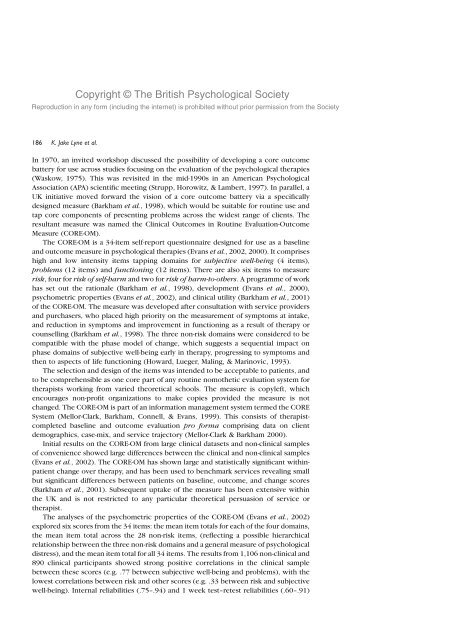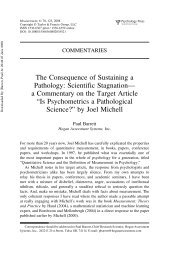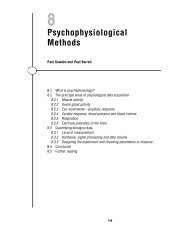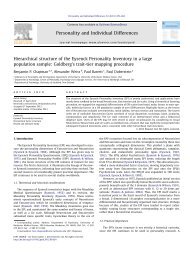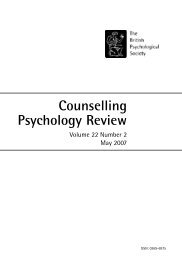Dimensions of variation on the CORE-OM - Paul Barrett
Dimensions of variation on the CORE-OM - Paul Barrett
Dimensions of variation on the CORE-OM - Paul Barrett
You also want an ePaper? Increase the reach of your titles
YUMPU automatically turns print PDFs into web optimized ePapers that Google loves.
Copyright © The British Psychological SocietyReproducti<strong>on</strong> in any form (including <strong>the</strong> internet) is prohibited without prior permissi<strong>on</strong> from <strong>the</strong> Society186K. Jake Lyne et al.In 1970, an invited workshop discussed <strong>the</strong> possibility <str<strong>on</strong>g>of</str<strong>on</strong>g> developing a core outcomebattery for use across studies focusing <strong>on</strong> <strong>the</strong> evaluati<strong>on</strong> <str<strong>on</strong>g>of</str<strong>on</strong>g> <strong>the</strong> psychological <strong>the</strong>rapies(Waskow, 1975). This was revisited in <strong>the</strong> mid-1990s in an American PsychologicalAssociati<strong>on</strong> (APA) scientific meeting (Strupp, Horowitz, & Lambert, 1997). In parallel, aUK initiative moved forward <strong>the</strong> visi<strong>on</strong> <str<strong>on</strong>g>of</str<strong>on</strong>g> a core outcome battery via a specificallydesigned measure (Barkham et al., 1998), which would be suitable for routine use andtap core comp<strong>on</strong>ents <str<strong>on</strong>g>of</str<strong>on</strong>g> presenting problems across <strong>the</strong> widest range <str<strong>on</strong>g>of</str<strong>on</strong>g> clients. Theresultant measure was named <strong>the</strong> Clinical Outcomes in Routine Evaluati<strong>on</strong>-OutcomeMeasure (<strong>CORE</strong>-<strong>OM</strong>).The <strong>CORE</strong>-<strong>OM</strong> is a 34-item self-report questi<strong>on</strong>naire designed for use as a baselineand outcome measure in psychological <strong>the</strong>rapies (Evans et al., 2002, 2000). It compriseshigh and low intensity items tapping domains for subjective well-being (4 items),problems (12 items) and functi<strong>on</strong>ing (12 items). There are also six items to measurerisk, four for risk <str<strong>on</strong>g>of</str<strong>on</strong>g> self-harm and two for risk <str<strong>on</strong>g>of</str<strong>on</strong>g> harm-to-o<strong>the</strong>rs. A programme <str<strong>on</strong>g>of</str<strong>on</strong>g> workhas set out <strong>the</strong> rati<strong>on</strong>ale (Barkham et al., 1998), development (Evans et al., 2000),psychometric properties (Evans et al., 2002), and clinical utility (Barkham et al., 2001)<str<strong>on</strong>g>of</str<strong>on</strong>g> <strong>the</strong> <strong>CORE</strong>-<strong>OM</strong>. The measure was developed after c<strong>on</strong>sultati<strong>on</strong> with service providersand purchasers, who placed high priority <strong>on</strong> <strong>the</strong> measurement <str<strong>on</strong>g>of</str<strong>on</strong>g> symptoms at intake,and reducti<strong>on</strong> in symptoms and improvement in functi<strong>on</strong>ing as a result <str<strong>on</strong>g>of</str<strong>on</strong>g> <strong>the</strong>rapy orcounselling (Barkham et al., 1998). The three n<strong>on</strong>-risk domains were c<strong>on</strong>sidered to becompatible with <strong>the</strong> phase model <str<strong>on</strong>g>of</str<strong>on</strong>g> change, which suggests a sequential impact <strong>on</strong>phase domains <str<strong>on</strong>g>of</str<strong>on</strong>g> subjective well-being early in <strong>the</strong>rapy, progressing to symptoms and<strong>the</strong>n to aspects <str<strong>on</strong>g>of</str<strong>on</strong>g> life functi<strong>on</strong>ing (Howard, Lueger, Maling, & Marinovic, 1993).The selecti<strong>on</strong> and design <str<strong>on</strong>g>of</str<strong>on</strong>g> <strong>the</strong> items was intended to be acceptable to patients, andto be comprehensible as <strong>on</strong>e core part <str<strong>on</strong>g>of</str<strong>on</strong>g> any routine nomo<strong>the</strong>tic evaluati<strong>on</strong> system for<strong>the</strong>rapists working from varied <strong>the</strong>oretical schools. The measure is copyleft, whichencourages n<strong>on</strong>-pr<str<strong>on</strong>g>of</str<strong>on</strong>g>it organizati<strong>on</strong>s to make copies provided <strong>the</strong> measure is notchanged. The <strong>CORE</strong>-<strong>OM</strong> is part <str<strong>on</strong>g>of</str<strong>on</strong>g> an informati<strong>on</strong> management system termed <strong>the</strong> <strong>CORE</strong>System (Mellor-Clark, Barkham, C<strong>on</strong>nell, & Evans, 1999). This c<strong>on</strong>sists <str<strong>on</strong>g>of</str<strong>on</strong>g> <strong>the</strong>rapistcompletedbaseline and outcome evaluati<strong>on</strong> pro forma comprising data <strong>on</strong> clientdemographics, case-mix, and service trajectory (Mellor-Clark & Barkham 2000).Initial results <strong>on</strong> <strong>the</strong> <strong>CORE</strong>-<strong>OM</strong> from large clinical datasets and n<strong>on</strong>-clinical samples<str<strong>on</strong>g>of</str<strong>on</strong>g> c<strong>on</strong>venience showed large differences between <strong>the</strong> clinical and n<strong>on</strong>-clinical samples(Evans et al., 2002). The <strong>CORE</strong>-<strong>OM</strong> has shown large and statistically significant withinpatientchange over <strong>the</strong>rapy, and has been used to benchmark services revealing smallbut significant differences between patients <strong>on</strong> baseline, outcome, and change scores(Barkham et al., 2001). Subsequent uptake <str<strong>on</strong>g>of</str<strong>on</strong>g> <strong>the</strong> measure has been extensive within<strong>the</strong> UK and is not restricted to any particular <strong>the</strong>oretical persuasi<strong>on</strong> <str<strong>on</strong>g>of</str<strong>on</strong>g> service or<strong>the</strong>rapist.The analyses <str<strong>on</strong>g>of</str<strong>on</strong>g> <strong>the</strong> psychometric properties <str<strong>on</strong>g>of</str<strong>on</strong>g> <strong>the</strong> <strong>CORE</strong>-<strong>OM</strong> (Evans et al., 2002)explored six scores from <strong>the</strong> 34 items: <strong>the</strong> mean item totals for each <str<strong>on</strong>g>of</str<strong>on</strong>g> <strong>the</strong> four domains,<strong>the</strong> mean item total across <strong>the</strong> 28 n<strong>on</strong>-risk items, (reflecting a possible hierarchicalrelati<strong>on</strong>ship between <strong>the</strong> three n<strong>on</strong>-risk domains and a general measure <str<strong>on</strong>g>of</str<strong>on</strong>g> psychologicaldistress), and <strong>the</strong> mean item total for all 34 items. The results from 1,106 n<strong>on</strong>-clinical and890 clinical participants showed str<strong>on</strong>g positive correlati<strong>on</strong>s in <strong>the</strong> clinical samplebetween <strong>the</strong>se scores (e.g. .77 between subjective well-being and problems), with <strong>the</strong>lowest correlati<strong>on</strong>s between risk and o<strong>the</strong>r scores (e.g. .33 between risk and subjectivewell-being). Internal reliabilities (.75–.94) and 1 week test–retest reliabilities (.60–.91)


